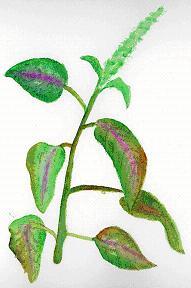Contribute
| Purslane - Amaranthus |
Usha Palaniswamy Ph.D., M.Ed.
01/19/2004
AMARANTHUS
Introduction
Amaranthus (Amaranthus spp., Amaranthaceae) is a tender annual that is native to India and perhaps other tropical countries. The word "amaranth" in Greek means "everlasting." Amaranthus species are perhaps everlasting in the sense that the crop has an ancient history and mentioned as the principle grain crop by the Aztecs 5,000 to 7,000 years ago and described as "mystical grains of the Aztecs," "super grain of the Aztecs," and the "golden grain of the Gods." The genus Amaranthus comprises of over 60 species of which about 15 are currently cultivated and consumed as a daily green vegetable in many parts of the world in Asia and Africa.
Cultivation and Traditional Uses
Amaranthus is grown widely in China, India, Africa, Sri Lanka, Nepal, South Pacific Islands, Caribbean, Greece, Italy, and in the United States. Amaranthus species are propagated by seeds. It thrives best in warm climates and sandy loams and fertile soils. Seeds are normally germinated in the nursery and the seedlings transplanted to the field. Seeds may also be sown directly outside and then thinned to obtain an optimal stand (30 cm between rows and 15 cm between plants). Though there are different species that are preferably grown when cultivated for leaf or seed, any single Amaranthus species can be grown for leaf or seed harvested as the economic yield.
Plants are harvested when tender and the whole plant uprooted when grown for use as a vegetable green or cut back a few inches and left to encourage lateral growth for seed harvests. When the plants are grown for seeds, the seeds are harvested when mature and the whole plant is uprooted. Amaranthus is an everyday green vegetable and all parts of the plant are eaten, cooked in curries and sauces, and made in to pickles and chutneys. The seeds are used to make flour and used in making local bread. Indian and Chinese traditional medicine has several uses for Amaranthus in their healing practices. The leaves are said to be cooling and a remedial for dysentery and dropsy, used as a febrifuge to reduce fevers, diuretic and to treat bronchitis. The leaves are crushed and applied externally as emollient and poultices on skin infections, dog bites, boils and wounds. A decoction made from the roots is taken to control hemorrhage caused by abortion.
Botany
Amaranthus is an erect annual growing to a height of 2 to 8 ft (0.6 to 2.4 m) high. The leaves are long or oval and some species have a purple coloring at the center of the lamina. The grain type amaranth plants have a main stem axis that terminates in an apical large branched inflorescence. The flowers are unisexual, purple, orange, red or gold in color, and are developed on branched flower clusters (named glomeruli, cymes with flowering panicles). The vegetable types of Amaranthus are generally smooth leafed, with an indeterminate growth habit, which produces new succulent axillary growth. The floral buds arise from the leaf axils. The amaranth seed is very small and can vary from light cream to golden or yellow brown or black in color.
Current Use and Health Value
Amaranthus is a green leafy vegetable rich ascorbic acid, and beta-carotene, which can be locally grown and can be recommended in the diet of the poor people to eradicate malnutrition, and blindness (1). Analysis of A. muricatus revealed that it is exceptionally rich in calcium (1533 mg/100 g) and had ideal Ca/P ratio (5.94), and its domestication is strongly recommended by several authors (2) and its superiority over soybean in its constituent functional properties (3). Extracts of Amaranthus also showed anti-viral properties (4)
Although amaranthus is an excellent source of iron and calcium, the bio-availability of these minerals needs to be evaluated as often a reported issue in numerous green leafy vegetables. The iron and calcium present in these leafy vegetables are often bound to the oxalic acids in the leaves and are not available for absorption (5). Studies also revealed that the iron content was influenced by the crop growth environment, and genetic variability in the different species of Amaranthus (A. tricolor and A. lividus had the highest total and bioavailable iron, while A. hypochondriacus had the lowest levels of all the species tested).
The potential for genetic improvement as well as environmental manipulation of iron nutritional quality in Amarathus has also been noted (6). Amaranthus seeds are also reported to be hypocholesterolemic, reducing cholesterol formation and accumulation (7).
References
1. Yadav SK, Sehgal S. 1999. Ascorbic acid and ß-carotene contents of some products developed from bathua (Chenopodium album) and cholai (Amaranthus tricolor) leaves. Int J Trop Agric 17(1-4):37-40.
2. Escudero NL, Albarracin G, Fernandez S, De Arellano LM, Mucciarelli S. 1999. Nutrient and antinutrient composition of Amaranthus muricatus. Plant Foods Hum Nutr 54(4):327-336.
3. Marcone MF, Kakuda Y. 1999. A comparative study of the functional properties of amaranth and soybean globulin isolates. Nahrung 43(6):368-373.
4. Mooi LY, Ali AM, Norhanom AB, Salleh KM, Murakami A, Koshimizu, K. 1999. Anti-tumor promoting activity of some Malaysian traditional vegetables (ulam). Nat Prod Sci 5(1):33-38.
5. Vityakon P, Standal BR. 1989. Oxalate in vegetable amaranth (Amaranthus gangeticus). Forms, contents, and their possible implications for human health. J Sci Food Agric 48(4):469-474.
6. Rangarajan A, Kelly, JF. 1998. Iron bioavailability from Amaranthus species: 1 - in vitro dialyzable iron for estimation of genetic variation. J Sci Food Agric 78(2):267-273.
7. Kalac P, Moudry J. 2000. Composition and nutritional value of amaranth seeds. Czech J Food Sci 18(5):201-206.
You may also access this article through our web-site http://www.lokvani.com/

